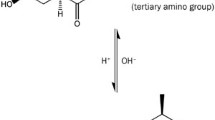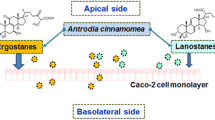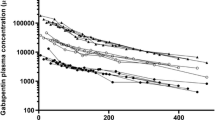Abstract
Intestinal absorption of two oxovanadium complexes, vanadyl acetylacetonate (VO(acac)2) and bis-(maltolato)-oxovanadium (VO(ma)2), has been compared using Caco-2 monolayers as a model system. The two compounds are similar in chemical structures but different in glucose-lowering effects. Our experimental results show that they are both transported via passive diffusion with apparent permeabilty coefficients (apical → basolateral) of (82.0 ± 6.7)×10−7 and (14.6 ± 0.7) ×10−7 cm · s−1 respectively. This suggests that absorptivity of VO(acac)2 is much higher than that of VO(ma)2. This difference may be related to the metabolism of either compound, or its ligand, or both in the course of the transport. However, This difference in absorption will cause the great difference in bioavailability, which might account for better efficacy of VO(acac)2 than VO(ma)2 as the insulin-mimic agent.
Similar content being viewed by others
References
Shechter, Y, Shisheva, A., Vanadium salt and the future treatment of diabetes, Endeavour, 1993, 17(1): 27–31.
Shechter, Y, Karlish, S. J., Insulin-like stimulation of glucose oxidation in rat adipocytes by vanadyl (IV) ions, Nature, 1980, 284(5756): 556–558.
Posner, B. I, Faure, R, Burgess, J. W. et al., Peroxovanadium compounds, A new class of potent phosphotyrosine phosphatase inhibitors which are insulin mimetics, J. Biol. Chem., 1994, 269(6): 4596–4604.
Fantus, I. G, Tsiani, E., Multifunctional actions of vanadium compounds on insulin signaling pathways: Evidence for preferential enhancement of metabolic versus mitogenic effects, Mol. Cell Biochem., 1998, 182(1–2): 109–119.
Thompson, K. H, McNeill, J. H, Orvig, C., Vanadium compounds as insulin mimics, Chem. Rev., 1999, 99(9): 2561–2572.
Yuen, V. G, Orvig, C, McNeill, J. H., Glucose-lowering effects of a new organic vanadium complex, bis(maltolato)oxovanadium (IV), Can. J. Physiol. Pharmacol., 1993, 71(3–4): 263–269.
Yuen, V. G, Orvig, C, McNeill, J. H., Comparison of the glucose-lowering properties of vanadyl sulfate and bis(maltolato) oxovanadium(IV) following acute and chronic administration, Can. J. Physiol. Pharmacol., 1995, 73(1): 55–64.
Reul, B. A, Amin, S. S, Buchet, J. P. et al., Effects of vanadium complexes with organic ligands on glucose metabolism: A comparison study in diabetic rats, Br. J. Pharmacol., 1999, 126(2): 467–477.
Yang, X. G., Lu, J. F., Wang, K., Across membrane transport, transformation and cytotoxicity of anti-diabetes vanadium compounds: An in vitro study with human erythrocytes as model system, Third International Symposium on Chemistry and Biological Chemistry of Vanadium, Osaka, 2001.
Sekar, N, Li, J, Shechter, Y., Vanadium salts as insulin substitutes: Mechanisms of action, a scientific and therapeutic tool in diabetes mellitus research, Crit. Rev. Biochem. Mol. Biol., 1996, 31(5–6): 339–359.
Miralpeix, M, Decaux, J. F, Kahn, A. et al., Vanadate induction of L-type pyruvate kinase mRNA in adult rat hepatocytes in primary culture, Diabetes, 1991, 40(4): 462–464.
Bosch, F, Hatzoglou, M, Park, E. A. et al., Vanadate inhibits expression of the gene for phosphoenolpyruvate carboxykinase (GTP) in rat hepatoma cells, J. Biol. Chem., 1990, 265(23): 13677–13682.
Borchardt, R. T, Pharmaceutical applications of cell culture: An overview, Pharmaceutical Applications of Cell and Tissue Culture to Drug Transport, New York: Plenum Press, 1991.
Walle, U. K, Walle, T., Taxol transport by human intestinal epithelial Caco-2 cells, Drug Metab Dispos, 1998, 26(4): 343–346.
Chasseaud, L. F., Accelerating ADME studies, Hum. Exp. Toxicol., 1995, 14(12): 991–992.
Coleman, R. A, Bowen, W. P, Baines, I. A. et al., Use of human tissue in ADME and safety profiling of development candidates, Drug Discov. Today, 2001, 6(21): 1116–1126.
Eddershaw, P. J, Beresford, A. P, Bayliss, M. K., ADME/PK as part of a rational approach to drug discovery, Drug Discov. Today, 2000, 5(9): 409–414.
Ekins, S, Waller, C. L, Swaan, P. W. et al., Progress in predicting human ADME parameters in silico, J. Pharmacol. Toxicol. Methods, 2000, 44(1): 251–272.
Ekins, S, Rose, J., In silico ADME/Tox: The state of the art, J. Mol. Graph. Model, 2002, 20(4): 305–309.
Li, A. P., Screening for human ADME/Tox drug properties in drug discovery, Drug Discov. Today, 2001, 6(7): 357–366.
Li, A. P, Segall, M., Early ADME/Tox studies and in silico screening, Drug Discov. Today, 2002, 7(1): 25–27.
Selick, H. E, Beresford, A. P, Tarbit, M. H., The emerging importance of predictive ADME simulation in drug discovery, Drug Discov. Today, 2002, 7(2): 109–116.
Yamashita, S, Furubayashi, T, Kataoka, M. et al., Optimized conditions for prediction of intestinal drug permeability using Caco-2 cells, Eur. J. Pharm. Sci., 2000, 10(3): 195–204.
Hidalgo, I. J, Raub, T. J, Borchardt, R. T., Characterization of the human colon carcinoma cell line (Caco-2) as a model system for intestinal epithelial permeability, Gastroenterology, 1989, 96(3): 736–749.
Artursson, P, Karlsson, J., Correlation between oral drug absorption in humans and apparent drug permeability coefficients in human intestinal epithelial (Caco-2) cells, Biochem. Biophys. Res. Commun., 1991, 175(3): 880–885.
Artursson, P, Palm, K, Luthman, K., Caco-2 monolayers in experimental and theoretical predictions of drug transport, Adv. Drug. Deliv. Rev., 2001, 46(1–3): 27–43.
Sun, Y, James, B. R, Rettig, S. J. et al., Oxidation Kinetics of the Potent Insulin Mimetic Agent Bis(maltolato)oxovanadium(IV) (BMOV) in Water and in Methanol, Inorg. Chem., 1996, 35(6): 1667–1673.
Crans, D. C., Chemistry and insulin-like properties of vanadium(IV) and vanadium(V) compounds, J. Inorg. Biochem., 2000, 80(1–2): 123–131.
Author information
Authors and Affiliations
Corresponding author
About this article
Cite this article
Yang, X., Yuan, L., Wang, K. et al. Comparison of intestinal absorption of two insulin-mimic vanadyl complexes using Caco-2 monolayers as model system. Chin.Sci.Bull. 48, 876–881 (2003). https://doi.org/10.1007/BF03325668
Received:
Published:
Issue Date:
DOI: https://doi.org/10.1007/BF03325668




